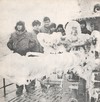
|
Home » Photo Gallery » Page 1
U-Boat Photo Gallery
| Contents of this chapter | |
| Page 1 | Page 2 |
| Page 3 | Page 4 |
| Page 5 | Page 6 |
| Page 7 | Page 8 |
| Page 9 | Page 10 |
| Page 11 | Page 12 |
| Page 13 | Page 14 |
| Page 15 | Page 16 |
| Page 17 | Page 18 |
| Page 19 | Submit Your Photo |
|
|
|
|
Authored by Uboataces |

|
This photo gallery attempts to capture the epic struggle of the U-boat force during the Battle of the Atlantic. During the war, German U-boats sent over 2900 ships and 14 million tons of allied shipping to the bottom of the sea, nearly cutting off the vital supplies of food, fuel and raw materials of Great Britain.
Page 1 Page 2 Page 3 Page 4 Page 5 Page 6 Page 7 Page 8
Page 9 Page 10 Page 11 Page 12 Page 13 Page 14 Page 15 Page 16
Page 17 Page 18 Page 19
|
U-410 on the day of it's commissioning ceremony 23 Feb 1942. Contributor: Nicolás Bracco Report |
|
Contributor: VEDRAN Report |
|
Contributor: VEDRAN Report |
|
Contributor: VEDRAN Report |
|
This is a WteckPhoto f U-171 Contributor: Geertjan Report |
|
This is HMS Seal captured at sea on May 05, 1940 by Ar196 seaplanes, commissioned in Jan 28, 1939 Contributor: Geertjan Report |
|
Contributor: Geertjan Report |
|
ADMIRAL KARL DOEINTZ WITH U-BOAT CREW. Contributor: VEDRAN Report |
|
U-BOAT VICTIM. Contributor: VEDRAN Report |
|
ATLANTIC Contributor: VEDRAN Report |
Page 1 Page 2 Page 3 Page 4 Page 5 Page 6 Page 7 Page 8
Page 9 Page 10 Page 11 Page 12 Page 13 Page 14 Page 15 Page 16
Page 17 Page 18 Page 19
If you have a U-boat photo to share, then we welcome you to upload it to this gallery. Photos kept in a private collection and never to be seen are a truly wasted resource, which might as well not exist. All photos are automatically rotated everyday so everybody gets their turn at the top.
Click here to submit your photo












